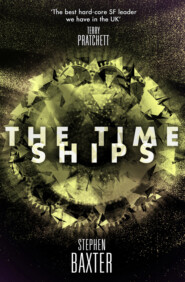По всем вопросам обращайтесь на: info@litportal.ru
(©) 2003-2024.
✖
Voyage
Автор
Год написания книги
2018
Настройки чтения
Размер шрифта
Высота строк
Поля
‘Agnew is an asshole,’ York said mildly.
‘Maybe, but he’s an asshole who likes spaceships and astronauts,’ Mike said, leaning forward from the back. ‘And that makes him my kind of asshole.’
‘Going to Mars is a beautiful idea,’ York said. ‘But it’s science fiction. Isn’t it?’
Mike squeezed her shoulder. ‘You’ve seen the XE-Prime. We can build this bird. All we need is the money.’
‘How much money?’
‘It’s not outrageous,’ Ben said. ‘Probably not as much as Apollo, in real terms. The whole program is going to be modular. A few basic components, used in different combinations for different missions. You’d have a Space Shuttle to get to orbit cheaply, a nuclear rocket for long-haul missions to the Moon and beyond, and cans – space station modules – you could assemble in different configurations. You’d put together your Mars ships using space station cans as habitation modules, and nuclear boosters –’
York felt like arguing, trying to get the unease out of her system – she had been shaken by what she’d seen at the test station. ‘But what’s it all for? More footprints and flags, like Apollo?’
‘No,’ Mike snapped.
There had been an edge of impatience in his voice since they’d left the Flats. She sensed her response there hadn’t been what he’d hoped for.
He said now, ‘Haven’t you been listening, Natalie? Agnew’s presented a great vision. We could be on Mars by 1982. And by 1990 we’ll have a hundred men in Earth orbit, forty-eight on the Moon, and forty-eight in a base on Mars –’
‘Oh, sure,’ she said, bristling. ‘Yes, actually, I have been listening. And I hear that Agnew gets booed when he talks in public about going to Mars. People don’t want this, Mike; the war is fucking up the economy too comprehensively.’
Ben, gratifyingly, looked startled to hear her swear.
“Well, I doubt Nixon’s going to buy it all anyhow,’ Ben said. ‘The word is he’s leaning a little toward the Space Shuttle, as the one element in the STG proposals to preserve over all the rest. Because it promises low-cost access to space. On the other hand, Nixon likes heroes …’
‘But he’s backed into a corner, by what Kennedy said to Armstrong and Muldoon in July,’ Mike said. ‘And by the pro-Mars statements he’s been issuing ever since.’
York grunted. ‘Nixon hates Kennedy. Besides, Kennedy’s just another opportunist. Do you really think he would have continued pumping funds into Apollo the way Johnson did, if he’d not been invalided out of the White House back in ’63? If he’d actually had to pay for any of the things he was able to call for, from his wheelchair?’
‘Johnson was a genuine space enthusiast,’ Mike said. ‘You’re too cynical, Natalie.’
‘Johnson was interested in his own advantage. Why else have you got so many NASA centers in the south?’
‘Does make you think, though,’ Ben said. ‘What if Kennedy hadn’t taken those bullets in Dallas? Or – what if they’d killed him, instead of his wife? Without him as a cheerleader on the sidelines, maybe the whole program would have got itself canceled.’
‘Anyway,’ York said, ‘I just hope that whatever happens this time around they make room for a few scientists among all you av-i-at-ors.’
‘Don’t listen to her, Ben,’ Conlig said. ‘She’s playing it cool. Guess what she keeps on the wall of her bedroom in her mom’s house.’
‘Shut up, Mike –’
‘Pictures of Mars.’
Priest looked at her, evidently intrigued.
‘Hell, I was just sixteen. For a while I got caught up in all that showbiz about Mariner 4 …’
Mariner 4 was a NASA space probe which reached Mars in July, 1964. Mariner hadn’t carried the fuel to put itself into orbit around Mars; it made one sweep past the planet, firing off pictures as it went. Mariner sent back twenty-one pictures, in all. They covered maybe one per cent of Mars’s surface.
Natalie York had never even thought about Mars, other worlds, before Mariner. She wasn’t even interested in astronomy, or space travel, or other worlds, or any of that. Astronomy was a subject for the handful of old men who controlled access to the big telescopes, and used them to pursue their obscure, decade-spanning projects. Even back in 1964, geology – the study of the Earth – was what captured her imagination. Stuff you could walk around in, and pick up, and examine with your eyes and hands.
Mariner made everything different. For a while, anyhow.
She remembered a teacher at school, trying to put over the basics of astronomy.
In July 1964, when Mariner reached Mars, the planet had been in opposition. Mars was a planet that circled the sun, like Earth; but its orbit was outside the Earth’s, and its year was twice as long. That meant its distance from Earth was constantly changing, as Earth scooted by on the inside track. But when sun, Earth and Mars were lined up, in that order, Mars would come closest to Earth. Opposition. That’s what it means. So at opposition, Mars is almost opposite the sun, seen from Earth. At its closest point.
She remembered, as she’d learned of this, a sudden sense of herself as a passenger on the Earth – as if it was a giant spinning spaceship, steaming past this great red liner called Mars.
To do their jobs, astronomers have to be able to figure out where they are, in relation to the rest of the universe. They have to be able to imagine, really and truly, that they aren’t living on a flat Earth.
She’d gotten copies of the pictures radioed back by Mariner 4, and had indeed taped them to her bedroom wall.
The first photo showed the limb of the planet, seen from close to; the horizon curved, and surface markings were vaguely, frustratingly visible. Still, the image was a hell of a contrast to the misty, unreal disk you could see through a telescope.
Mariner’s photos showed how Mars would look to an orbiting astronaut.
The next few pictures showed views of the surface, as if looking down from directly overhead. The monochrome images looked like aerial pictures of a desert, Arizona maybe …
Ben Priest said now, ‘You know, Mariner was a big shock to us all. Before Mariner, we thought we understood Mars pretty well. You could walk around on the surface with nothing more than a facemask. We thought we saw seasonal changes in dark patches on the surface, that were maybe down to some kind of spreading vegetation.
‘But now, everything looks different. We had it wrong – all of it. Earth-like Mars certainly isn’t.’
It was Mariner’s seventh picture that was the real surprise.
The seventh picture showed craters. Nobody was expecting to find those.
Not Arizona, then. Mars looked more like the Moon.
Priest said, ‘We know now the atmosphere is impossibly thin. It’s mostly carbon dioxide, and there’s no oxygen, and hardly any water vapor. Not even nitrogen … Mariner didn’t find any canals, incidentally. Even though it flew over an area where a lot of the most prominent canals were expected.
‘All our ideas were turned upside down by this. With such a thin atmosphere, any life must be very hardy. Nothing like terrestrial life at all. But, of course, the question of life won’t be settled until humans land there. It was one hell of a disappointment, the NASA guys tell me. Suddenly, Mars became a place it wasn’t worth traveling to. If we don’t make it to Mars, if the funding and resources aren’t assembled, then for me, that shock of Mariner 4 will have been the turning point.’
York shrugged. ‘But NASA oversold Mars for years. It was a kind of holiday resort in the sky, teeming with life, justifying all the billions they wanted to pour into rockets and spaceships …’
Priest laughed. ‘A holiday resort. I like that.’
To York, Mars was much more than that. After Mariner she’d become interested in Mars, and its history in the human imagination. She got books from the library. Mars as the Abode of Life by Percival Lowell, New York, 1909; Mars and its Canals by Lowell, New York, 1906 … She remembered fantastic, gaudy pictures of huge irrigation canals dug across the face of a dying, drying Mars, long descriptions of the waves of vegetation and the herds of animals which must sweep across the red Martian plains. The Mars Project: Wernher von Braun, University of Illinois, 1953. It had a big rocket ship on the cover, like a kid’s book. Von Braun wanted to build ten spaceships in Earth orbit, each weighing three and a half thousand tons, and carrying seven men. It would take nine hundred flights to orbit to assemble the fleet. There would be two-hundred-ton landing boats, to take fifty people down to the surface for a year-long stay … These visions, she’d thought, were a boy’s dreams of power, dressed up as serious engineering plans.
York had put this stuff aside. Even at the age of sixteen, York was hot on science, on the strictness and logic of it; she found herself getting unreasonably impatient at illogic, and wishful thinking, and the emotional coloration of rational processes of all sorts.
(Actually she was much too severe for most of the boys her mother tried to match her with. You’d think that someone who’d suffered as messy a divorce as Maisie York would learn not to meddle in other people’s relationships …)
The fact was, to her, the real Mars was a hell of a lot more interesting than Lowell’s anthropocentric dreams.
Because of Mariner, Mars had turned into a place you could do some geology.
How would the geology of Mars differ from Earth’s? What would that tell you about Earth, that you couldn’t have learned from staying at home? A hell of a lot, probably.











